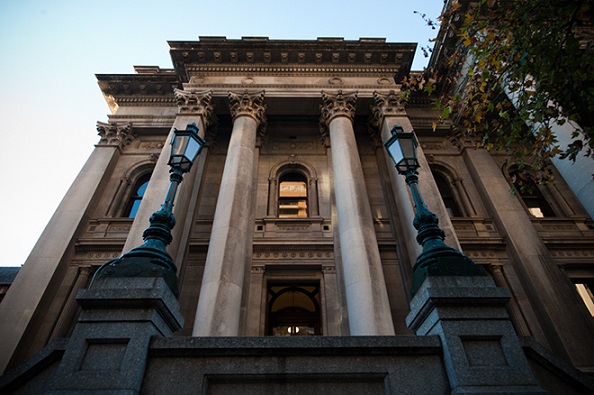‘Build less’: The advice to government on how to avoid carbon emissions in big infrastructure projects

- by Admin
- March 1, 2024
From the cement and steel used in new train stations to the energy spent in building a new hospital and the driving of petrol-fuelled cars on big new roads — major infrastructure projects are linked to a lot of carbon emissions.
The problem is, across Australia, experts say those emissions are not being consistently measured.
Infrastructure Victoria is calling on the state government to introduce a dollar value per tonne of carbon emissions to inform business cases for new roads, rail projects, schools and hospitals.
It also wants the government to consider building fewer big projects and instead prioritise other “no-build” solutions like better traffic light management to combat congestion.
New South Wales currently has a road map to decarbonise infrastructure, which includes measuring all government infrastructure and implementing a carbon management system by 2025.
But with the construction industry accounting for 18 per cent of global emissions, experts say Australia will need to move faster to reduce emissions from big building works.
What is the cost of carbon emissions?
Infrastructure Victoria chief executive Jonathan Spear said while most big projects in Victoria do measure carbon emissions, there is no consistent approach across government departments on how to do it.
“We can’t manage what we don’t measure,” he said.
“So there’s a really important opportunity for governments to measure the amount of carbon we are embedding and creating when we commit to infrastructure projects.”
Infrastructure Victoria has released a report finding the government’s guidance on the value of carbon hasn’t been updated since 2013.
The report found the Suburban Rail Loop used a value of $46 per tonne of carbon dioxide equivalent, but the North East Link used a value of $52.40.
Infrastructure Victoria recommends adopting an interim carbon value of $123 per tonne, similar to what is used in NSW.
Reduce, reuse, recycle
The report urges governments to consider alternatives to big building projects in the first place, like introducing off-peak fares for public transport to try to spread demand throughout the day, or better-managing traffic lights to help ease congestion.
Mr Spear said there are many things governments should do before they look to expensive new building projects.
“We can make sure we are making better use of the infrastructure we already have, we can be maintaining it well, we can upgrade it incrementally and we can change the way we use it so we continue to get the most out of it,” he said.
For example, a VicRoads program found that adjusting traffic light cycles along Canterbury Road in the city’s east resulted in drivers saving up to 6 per cent on their travel times.
What about the need for new roads and buildings?
Mr Spear said once government departments had incorporated the cost of emissions into a project’s business case, it would be unlikely to stop a project going ahead.
But he said it would help maintain a focus on reducing emissions throughout the project, for example by reducing the amount of cement used in road projects, or by using renewable energy to power construction sites.
The report points to a school in Warragul North, south-east of Melbourne, which took eight weeks to build and install using modules that were built off-site, leading to a reduction in the impact on the environment.
The report called on the government to adopt a 28–33 per cent emissions reduction target by 2026.
The Victorian government already has a policy requiring bidders on transport projects to use recycled and reused materials in construction.
In a statement, a Victorian government spokesperson said big projects like the Metro Tunnel and Suburban Rail Loop will “slash emissions”, by taking cars off the roads.
“We acknowledge Infrastructure Victoria’s report and will consider the recommendations,” they said.
But experts say Australia must go further
Philip Oldfield from the University of NSW’s School of Built Environment said measuring carbon emissions in big projects is becoming more mainstream.
“We’re now seeing a great acknowledgement and an awakening of embodied carbon,” Professor Oldfield said.
He said some European countries, including France and the Netherlands, have put in place a regulated maximum amount of emissions per square metre of infrastructure.
He said NSW is now requiring new buildings to measure carbon emissions, but he wants to see Australia put caps in place.
“Movements have been made (in Australia), we’re getting there, but we need to move faster,” he said.
While populations continue to grow, particularly on the outskirts of big cities, Professor Oldfield said the benefits of new infrastructure projects must be measured against both the economic and the environmental cost.
“Globally we have this great challenge to improve people’s lives, but we have to be careful about how we spend our carbon emissions, and the key is to measure it,” he said.
The Latest News
-
December 26, 2024Texas Freshman Tennis Star Maya Joint To Turn Pro Ahead Of Australian Open
-
December 26, 2024Injured Halep forced to pull out of Australian Open
-
December 26, 2024Australian Open 2025: Simona Halep withdraws from qualifying because of injury
-
December 26, 2024As big changes come to the PGA Tour, a look back at the complicated path to all-exempt era – Australian Golf Digest
-
December 26, 2024Rules of Golf Review: It was only a tap-in, but my opponent raked his putt into the hole. Is that legal? – Australian Golf Digest





